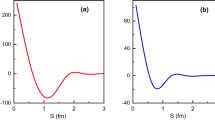Abstract.
The exotic nonstrange \( \Delta\Delta\) dibaryon with \( I(J^{P}) = 0(3^{+})\) has been confirmed by the experimental data reported by WASA-at-COSY Collaboration, and the result is consistent with our theoretical prediction in the chiral SU(3) quark model and extended chiral SU(3) quark model, showing that the effect from hidden-color channel (CC is important. In the present work, we further investigate another exotic nonstrange \( \Delta\Delta\) dibaryon with \( I(J^{P}) = 3(0^{+})\) in the chiral SU(3) quark model that describes the energies of baryon ground states and the nucleon-nucleon (NN) scattering data satisfactorily. We perform a dynamical coupled-channel study of the \( \Delta\Delta\) -CC system with \( I(J^{P}) = 3(0^{+})\) within the framework of resonating group method (RGM). We find that the binding energy of \( I(J^{P}) = 3(0^{+})\) state is about 22.3 MeV and a root-mean-square radius (RMS) of 1.03 fm in single-channel calculation. Then we extend the model to include the CC channel to further study the \( I(J^{P}) = 3(0^{+})\) state and find that the binding energy is about 31.3 MeV and RMS is 0.97 fm in coupled-channel calculation. We can see that the CC channel coupling has a relatively large effect on this state. The color screening effect is further considered and we find that the bound state property will not change much. It is shown that the binding energy of this state is stably ranged around several tens of MeV; it means that its mass is always lower than the threshold of the \( \Delta\Delta\) channel and higher than the mass of \( N\Delta\pi\).
Similar content being viewed by others
References
M. Bashkanov et al., Phys. Rev. Lett. 102, 052301 (2009)
WASA-at-COSY Collaboration (P. Adlarson et al.), Phys. Rev. Lett. 106, 242302 (2011)
WASA-at-COSY Collaboration & SAID DAC (P. Adlarson et al.), Phys. Rev. Lett. 112, 202301 (2014)
WASA-at-COSY Collaboration & SAID DAC (P. Adlarson et al.), Phys. Rev. C 90, 035204 (2014)
F.J. Dyson, N.H. Xuong, Phys. Rev. Lett. 13, 815 (1964)
A. Gal, H. Garcilazo, Phys. Rev. Lett. 111, 172301 (2013)
A. Gal, H. Garcilazo, Nucl. Phys. A 928, 73 (2014)
H.X. Huang, J.L. Ping, F. Wang, Phys. Rev. C 89, 034001 (2014)
H.X. Chen, E.L. Cui, W. Chen, T.G. Steele, S.L. Zhu, Phys. Rev. C 91, 025204 (2015)
Y. Dong, P. Shen, F. Huang, Z. Zhang, Phys. Rev. C 91, 064002 (2015)
M. Bashkanov, H. Clement, T. Skorodko, Eur. Phys. J. A 51, 87 (2015)
X.Q. Yuan, Z.Y. Zhang, Y.W. Yu, P.N. Shen, Phys. Rev. C 60, 045203 (1999)
Z.Y. Zhang, Y.W. Yu, P.N. Shen, L.R. Dai, A. Faessler, U. Straub, Nucl. Phys. A 625, 59 (1997)
D.L. Hill, J.A. Wheeler, Phys. Rev. 89, 1102 (1953)
M. Kamimura, Suppl. Prog. Theor. Phys. 62, 236 (1977)
Q.B. Li, P.N. Shen, Z.Y. Zhang, Y.W. Yu, Nucl. Phys. A 683, 487 (2001)
Y.W. Yu, Z.Y. Zhang, P.N. Shen, L.R. Dai, Phys. Rev. C 52, 3393 (1995)
L.R. Dai, Z.Y. Zhang, Y.W. Yu, P. Wang, Nucl. Phys. A 727, 321 (2003)
M. Gell-Mann, M. Levy, Nuovo Cimento 16, 705 (1960)
A.M. Kusainov, V.G. Neudatchin, I.T. Obukhovsky, Phys. Rev. C 44, 2343 (1991)
A. Buchmann, E. Fernandez, K. Yazaki, Phys. Lett. B 269, 35 (1991)
E.M. Henley, G.A. Miller, Phys. Lett. B 251, 453 (1991)
Z.Y. Zhang, Y.W. Yu, C.R. Ching, T.H. Ho, Z.D. Lu, Phys. Rev. C 61, 065204 (2000)
K. Shimizu, Rep. Prog. Phys. 52, 1 (1989)
Z.Y. Zhang, Y.W. Yu, P.N. Shen, X.Y. Shen, Y.B. Dong, Nucl. Phys. A 561, 595 (1992)
Author information
Authors and Affiliations
Corresponding author
Additional information
Communicated by R. Alkofer
Rights and permissions
About this article
Cite this article
Dai, L.R., Zhang, Y.N., Sun, Y.L. et al. The nonstrange dibaryon and hidden-color effect in a chiral quark model. Eur. Phys. J. A 52, 295 (2016). https://doi.org/10.1140/epja/i2016-16295-6
Received:
Accepted:
Published:
DOI: https://doi.org/10.1140/epja/i2016-16295-6




